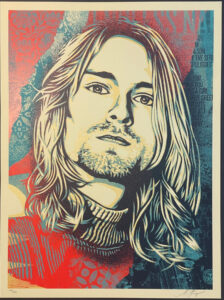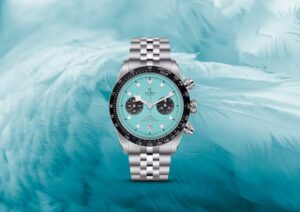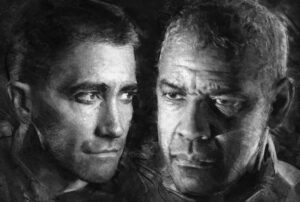In 2021, Shepard Fairey released Kurt Cobain Endless Nameless, a limited-edition silkscreen print that crystallizes a layered meditation on legacy, identity, and the enduring resonance of counterculture. Known globally for his Obey Giant campaign and the iconic Hope poster of Barack Obama, Fairey turned his gaze to a different kind of icon—Kurt Cobain, the Nirvana frontman whose haunting vulnerability and anti-establishment ethos defined an era.
The work blends Fairey’s trademark design language—bold iconography, political undertones, propaganda-style framing—with the raw emotional energy of Cobain’s music and persona. With gold metallic inks, the screenprint elevates its subject to the level of a secular saint—shimmering, mythic, and yet irrevocably human.
The Visual Language of Resistance
Fairey’s composition for Endless Nameless is tightly structured yet emotionally volatile, mirroring the dynamic tension at the heart of Cobain’s artistry. Central to the piece is a portrait of Cobain, filtered through Fairey’s signature stenciled style. It’s not photorealism; it’s icon-making. Cobain stares outward, eyes partially obscured in shadow. His expression is neither rage nor serenity—more a visual echo of a scream just subsiding.
Behind and around him, radiating lines and ornamental detailing recall Eastern religious art and 20th-century propaganda posters alike. These visual strategies have long been part of Fairey’s aesthetic toolkit, serving to deconstruct the power of symbols and elevate subjects typically excluded from traditional canons of heroism.
The use of gold metallic ink is particularly striking. Gold, in both religious and political art, signifies reverence, purity, and sometimes corruption. Here, it complicates Cobain’s identity. Is he being canonized or commodified? Is this celebration or cautionary tale? The tension is deliberate—Fairey doesn’t resolve it.
From Grunge to Graphic
The print’s title, Endless Nameless, is pulled from Nirvana’s hidden track of the same name—a chaotic, distorted soundscape that eschews structure and melody in favor of violent release. That track, often seen as the antithesis of mainstream appeal, sits in sharp contrast to Nirvana’s more polished singles. Fairey’s homage nods to this chaos, not in sound but in form.
Though visually precise, the design carries undertones of rupture and agitation. The background patterns don’t just decorate—they destabilize. They flicker, shift, shimmer. The tension between order and disorder is a direct translation of Nirvana’s aesthetic: punk roots filtered through pop accessibility.
Political Undertones
Fairey has always been a political artist, whether he’s designing murals that critique climate change denial or releasing anti-war prints with guerrilla immediacy. In Cobain, he found a kindred spirit—someone who questioned systems, detested hypocrisy, and resisted becoming a product, even as he was consumed by fame.
The silkscreen doesn’t preach, but it speaks. Cobain’s upward gaze evokes a search for meaning, for escape, for truth beyond the noise. The ornamental elements—mandalas, sunbursts, industrial motifs—become symbolic battlegrounds. They are as much about spiritual hunger as they are about the machinery of mass media.
Fairey seems to be asking: what happens when a voice that challenged the system becomes part of its iconography? What is the afterlife of rebellion in a commodified culture?
Medium and Message
Silkscreen printing itself is a meaningful choice. Historically used in both fine art and mass communication—from Andy Warhol to punk zines—it’s a medium of multiplicity. Fairey’s use of gold metallic ink further complicates the notion of value: are we looking at a precious relic or a reproducible object?
Each print in the limited run is both identical and unique, with hand finishing and individual numbering that situate the object in a space between the artisanal and the industrial. It’s a method that mirrors Cobain’s career—straddling underground ethos and global fame, lo-fi grit and platinum records.
Reception and Cultural Resonance
Upon its release, Kurt Cobain Endless Nameless was met with enthusiasm from collectors and fans alike. Many saw it not just as a tribute to Cobain, but as an artifact of contemporary rock art—a reminder that visual storytelling still plays a role in shaping how we remember musicians long after the final note.
Critics praised the piece for its emotional charge and stylistic clarity. Fairey’s ability to navigate the space between homage and critique, reverence and resistance, is evident here. The work doesn’t idolize Cobain as a flawless martyr, but it does refuse to let his voice be forgotten.
In an era where celebrity often becomes hollow spectacle, Fairey’s print reminds us that Cobain was more than a voice or a style—he was a question that remains unanswered.
Legacy in Layers
What ultimately makes Endless Nameless so compelling is its refusal to simplify. It doesn’t flatten Cobain’s contradictions—it frames them. In Fairey’s hands, the print becomes more than just a visual ode. It’s a lens through which we examine art, commodification, memory, and meaning.
The gold shimmer doesn’t polish Cobain’s legacy—it illuminates the fractures. And in doing so, it honors the complexity of both the artist and the era he defined.
Technical Details:
- Title: Kurt Cobain Endless Nameless
- Artist: Shepard Fairey
- Year: 2021
- Medium: Silkscreen print with gold metallic inks
- Edition: Limited (numbered and signed)
- Dimensions: Approx. 18 x 24 inches
Fairey’s Kurt Cobain Endless Nameless is not just a portrait—it’s a dialogue between past and present, silence and sound, legend and loss. It’s a reminder that while the music may stop, the message doesn’t. And sometimes, the most deafening truths are those rendered in silence—and in gold.
No comments yet.









